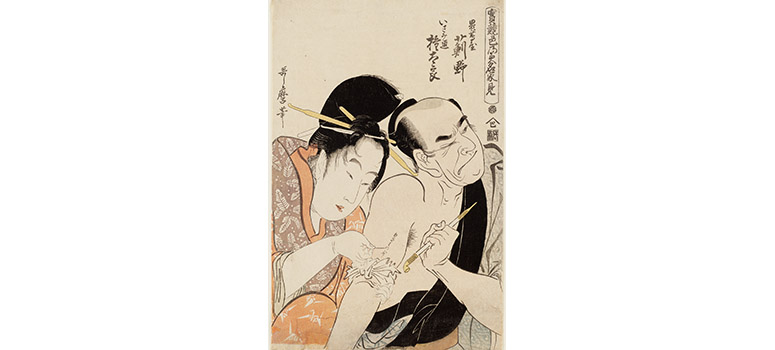A cursory look at fellow ferry passengers on any given day will reveal that scores of them are rather elaborately "inked" in some fashion or another.

PR Asian Art Museum
BY PAUL DUCLOS
Published: July, 2019
A cursory look at fellow ferry passengers on any given day will reveal that scores of them are rather elaborately “inked” in some fashion or another. What was once the domain of sailors, longshoremen and old sea dogs has become so common that social scientists estimate nearly 50 million Americans are sporting some kind of tattoo these days.
The craze is not without precedent, however, as a new exhibition at the Asian Art Museum demonstrates. Tattoos in Japanese Prints, which runs through August 18, focuses on Edo (modern Tokyo) when it was a center for cutting-edge art in the 19th century.
With more than 60 superb works from Boston’s Museum of Fine Arts’ collection, Tattoos in Japanese Prints uncovers the complex interplay between ink on paper and ink on skin, revealing the origin of some of the world’s most enduring and popular tattoo motifs. The exhibition traces these designs to a famous set of prints by artist Utagawa Kuniyoshi (1797–1861), a series which was itself inspired by a popular 14th-century Chinese martial-arts novel.
“By putting the aesthetic genius of Japanese printmakers on full display, this exhibition underscores how the popular culture of late Edo-period Japan continues to influence how we express ourselves today,” said Jay Xu, Asian Art Museum director and CEO. “We’re excited to share such eye-catching prints with every kind of visitor—from collectors and connoisseurs familiar with the technical virtuosity of these artworks, to audiences who want to understand more about the surprising history of their own personal ink.”
While searching for new subjects for his prints, Kuniyoshi hit upon the idea of a print series focused on hero-bandits from the famed Water Margin tale, which was first translated from Chinese and published in Japan between 1757 and 1790. Kuniyoshi called his series, published in the late 1820s, One Hundred and Eight Heroes of the Popular Water Margin. Significantly for the history of tattoo art, Kuniyoshi gave many of the heroes elaborate tattoos, even if the original text did not mention any inked embellishment on their bodies.
“Tattoos in Japanese Prints lets museum visitors see how creative ideas flowed from popular art into urban life, and back again,” said Laura Allen, Asian Art Museum chief curator and curator of Japanese art. “Scholars are uncertain whether Kuniyoshi’s series kicked off the 40-year tattoo boom that followed, or if a nascent fad for body art prompted Kuniyoshi’s artwork, but the ample prints we have from this period by Kuniyoshi and others, who freely imagined elaborate tattoos, probably both inspired and reflected the real-life trend.”
New Book on Chinese Immigrants
Ferry riders who have paid a visit to Angel Island well know about the shameful treatment given to quarantined immigrants from China in the 19th and early 20th centuries. A new work of scholarship provides yet more information on the remarkable resilience of the new citizens who were able to make it to San Francisco’s Chinatown to begin a new life under daunting circumstances.
Beginning in 1874, the Occidental Mission Home on the edge of San Francisco’s Chinatown served as a gateway to freedom for thousands of enslaved and vulnerable young Chinese women and girls. Run by a courageous group of female abolitionists who fought the slave trade in Chinese women, it survived earthquakes, fire, bubonic plague and violence directed against its occupants and supporters.
With compassion and an investigative historian’s sharp eye, Julia Flynn Siler tells the story of both the abolitionists who challenged the corrosive anti-Chinese prejudices of the time and the young women who dared to flee their fate in her new book, The White Devil’s Daughter: Fighting Slavery in San Francisco’s Chinatown.
She relates how the women who ran the home defied contemporary convention—even occasionally breaking the law—by physically rescuing children from the brothels where they worked or by snatching them off ships as they were being smuggled in. The book also includes the story of how they helped bring the exploiters to justice. She also shares the moving stories of many of the girls and young women who sought refuge at the mission, and she writes about the lives they went on to lead. This is a remarkable chapter in an overlooked part of our history, told with sympathy and vigor.
The book is available online and at the SF Asian Art Museum. For more information, see www.asianart.org.
Follow Paul Duclos’ Cultural Currents online with his blog at: www.duclosculturalcurrents.com

